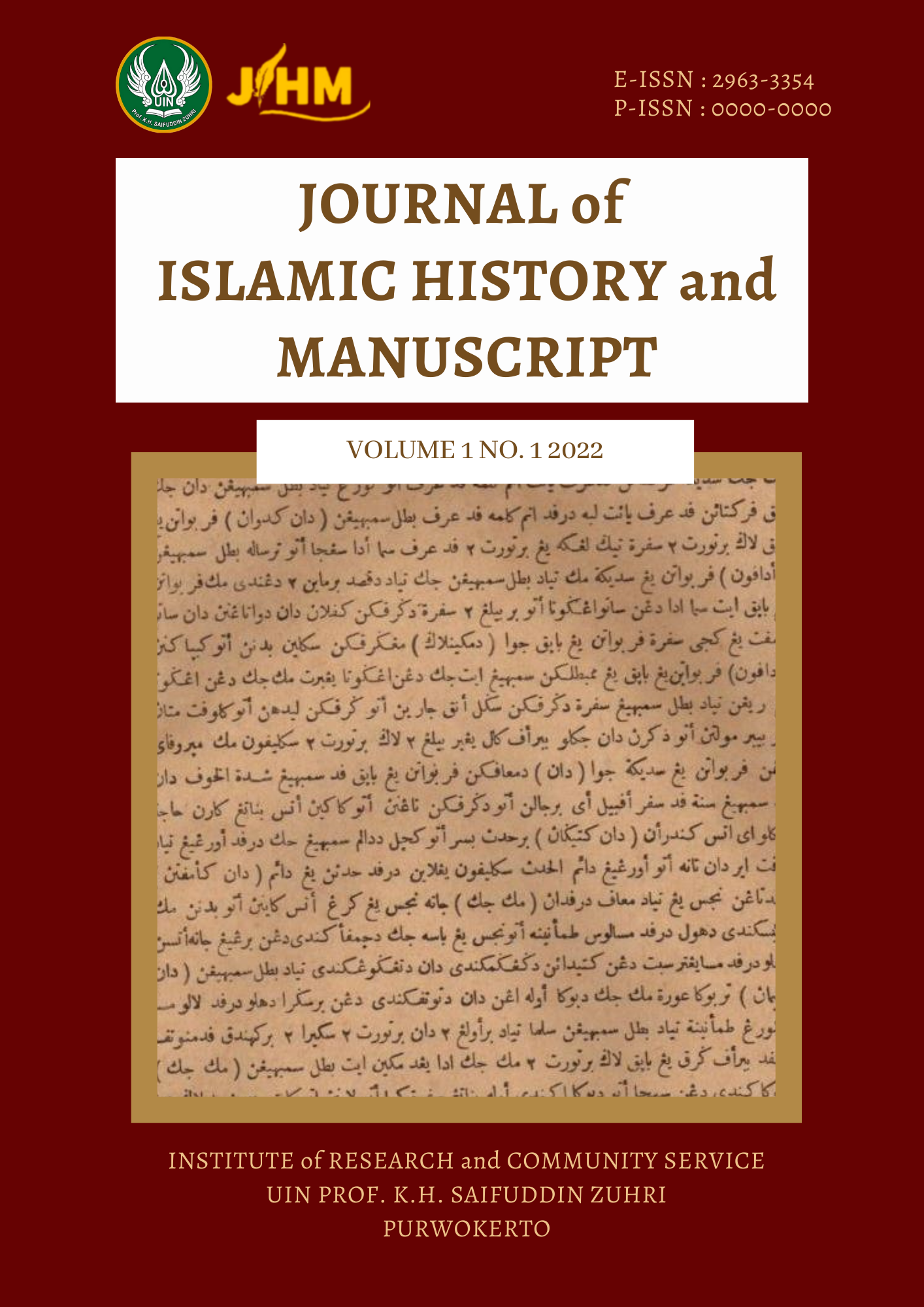Dearabization of Islamic Government during the Abbasid Dynasty
DOI:
https://doi.org/10.24090/jihm.v1i1.6591Keywords:
Dearabization, Dzimmi, Government of Abbasyd Dynasty, MawaliAbstract
The Arabization movement was one of the government's political models during the Umayyad Dynasty. Arabization, known as ta'rib became a characteristic of the administration of the Umayyad dynasty, which influenced the socio-political life of Arab Muslims, the Mawali, and Dzimmi groups. The influence of social strata became a feature of the Arabization movement at that time. During the Abbasid dynasty, this movement began to fade, especially the problem of social strata that prioritized Arab Muslims. The Abbasid dynasty, from the point of view of Islamic civilization, generally continued the reign of the Umayyad dynasty, but some aspects of government changed, especially the issue of Arabization. This study focuses more on the impact of the reduced priority of Arab Muslims during the Abbasid dynasty. The demise of the Abbasid dynasty gave a new face to the development of politics, economy, government administration, education, and law enforcement aspects. This research is a type of qualitative research using qualitative descriptive analysis. This type of research is historical research with a socio-political approach to government. The qualitative method used in this study uses historical research methodology, namely heuristics, verification, interpretation, and historiography. Based on the heuristic aspect, the researcher used a literature study. The results of this study indicate that the existence of Dearabization had a significant impact on the reign of the Abbasid dynasty. The policies taken by the caliphs of the Abbasid dynasty gave a new color to the development of politics, economy, government administration, education, and law.References
Abdurrahman, Dudung, Metodologi Penelitian Sejarah Islam, Yogyakarta, Ombak, 2011.
Abu Bakar, I. (2008). Sejarah Peradaban Islam. Malang: UIN Press.
Ajid Thohir, Studi Kawasan Dunia Islam: Perspektif Etno-Linguistik dan Geo- Politik, Jakarta: Raja Grafindo Persada, 2007.
Al Fiqi, Sa’ad Karim. (2009). Penghianat-Penghianat dalam Sejarah Islam, Terj. H. Muhyiddin Mas Rida, Lc. Jakarta: Pustaka al-Kautsar.
Amstrong, K. (2001) Sejarah Tuhan, Bandung, Mizan.
Amstrong, K. (1992). Masa Depan Tuhan, Bandung, Mizan.
Amrulloh, Muhammad Afif. (2017). Analysis of Phonological Changes in the Form of Mu'arrabah Sentences. Arabiyat: Journal of Arabic and Arabic Language Education. Vol.4, No.2. p. 91
A. Syalabi. (1992). Sejarah dan kebudayaan Islam 2 Jakarta: Pustaka al Husna.
A. Syalabi. (1992a). Sejarah dan kebudayaan Islam 3 Jakarta: Pustaka al Husna.
Badri Yatim, M.A., Sejarah Peradaban Islam, Jakarta: Rajagrafindo Persada, 2008.
Engineer Asghar Ali, Asal Usul dan Perkembangan Islam: Analisis Pertumbuhan Sosio-Ekonomi, Terj. Imam Baehaqi Yogyakarta, Pustaka Pelajar, 1999.
Fouda, F. (2003). al Haqiqah al Ghaybah, Terj. Novriantoni, Mesir: Dar wa Matabi’al Mustaqbal.
Hitti, Philip K. (2006). History of The Arabs. Jakarta: PT. Serambi Ilmu.
Istianah Abu Bakar, Sejarah Peradaban Islam, Malang: UIN Press, 2008.
Kusuma, Mirza T. (2014). Ketika Makkah menjadi Las Vegas agama, politik, dan ideologi. Jakarta: PT Gramedia Pustaka Utama.
Sjadzali Munawir, H. M.A, Islam dan Tata Negara, Jakarta, Universitas Indonesia (UI-Press), 1990.
Supriyadi, D. (2008). History of Islamic Civilization. Bandung: Pustaka Setia.
Suyuthi, I. (2001). Tarikh Khulafa. Jakarta: Pustaka al Kaustar.
Yatim, B. (2008). Sejarah Peradaban Islam. Jakarta: Rajagrafindo Persada.
Abu Bakar, I. (2008). Sejarah Peradaban Islam. Malang: UIN Press.
Ajid Thohir, Studi Kawasan Dunia Islam: Perspektif Etno-Linguistik dan Geo- Politik, Jakarta: Raja Grafindo Persada, 2007.
Al Fiqi, Sa’ad Karim. (2009). Penghianat-Penghianat dalam Sejarah Islam, Terj. H. Muhyiddin Mas Rida, Lc. Jakarta: Pustaka al-Kautsar.
Amstrong, K. (2001) Sejarah Tuhan, Bandung, Mizan.
Amstrong, K. (1992). Masa Depan Tuhan, Bandung, Mizan.
Amrulloh, Muhammad Afif. (2017). Analysis of Phonological Changes in the Form of Mu'arrabah Sentences. Arabiyat: Journal of Arabic and Arabic Language Education. Vol.4, No.2. p. 91
A. Syalabi. (1992). Sejarah dan kebudayaan Islam 2 Jakarta: Pustaka al Husna.
A. Syalabi. (1992a). Sejarah dan kebudayaan Islam 3 Jakarta: Pustaka al Husna.
Badri Yatim, M.A., Sejarah Peradaban Islam, Jakarta: Rajagrafindo Persada, 2008.
Engineer Asghar Ali, Asal Usul dan Perkembangan Islam: Analisis Pertumbuhan Sosio-Ekonomi, Terj. Imam Baehaqi Yogyakarta, Pustaka Pelajar, 1999.
Fouda, F. (2003). al Haqiqah al Ghaybah, Terj. Novriantoni, Mesir: Dar wa Matabi’al Mustaqbal.
Hitti, Philip K. (2006). History of The Arabs. Jakarta: PT. Serambi Ilmu.
Istianah Abu Bakar, Sejarah Peradaban Islam, Malang: UIN Press, 2008.
Kusuma, Mirza T. (2014). Ketika Makkah menjadi Las Vegas agama, politik, dan ideologi. Jakarta: PT Gramedia Pustaka Utama.
Sjadzali Munawir, H. M.A, Islam dan Tata Negara, Jakarta, Universitas Indonesia (UI-Press), 1990.
Supriyadi, D. (2008). History of Islamic Civilization. Bandung: Pustaka Setia.
Suyuthi, I. (2001). Tarikh Khulafa. Jakarta: Pustaka al Kaustar.
Yatim, B. (2008). Sejarah Peradaban Islam. Jakarta: Rajagrafindo Persada.
Downloads
Published
13-09-2022
How to Cite
Riyadi, A. S. M., & Putra, M. H. A. (2022). Dearabization of Islamic Government during the Abbasid Dynasty. Journal of Islamic History and Manuscript, 1(1), 53–68. https://doi.org/10.24090/jihm.v1i1.6591
Issue
Section
Articles
License
Authors who publish in this journal agree to the following terms:
- Authors retain copyright and grant the journal right of first publication with the work simultaneously licensed under a Creative Commons Attribution 4.0 International License. that allows others to share the work with an acknowledgment of the work's authorship and initial publication in this journal.
- Authors can enter into separate, additional contractual arrangements for the non-exclusive distribution of the journal's published version of the work (e.g., post it to an institutional repository or publish it in a book), with an acknowledgment of its initial publication in this journal.
- Authors are permitted and encouraged to post their work online (e.g., in institutional repositories or on their website) before and during the submission process, as it can lead to productive exchanges and earlier and greater citation of published work (See The Effect of Open Access).

















